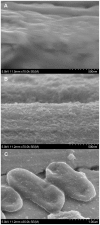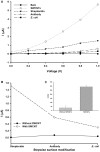Single walled carbon nanotube-based junction biosensor for detection of Escherichia coli
- PMID: 25233366
- PMCID: PMC4169404
- DOI: 10.1371/journal.pone.0105767
Single walled carbon nanotube-based junction biosensor for detection of Escherichia coli
Abstract
Foodborne pathogen detection using biomolecules and nanomaterials may lead to platforms for rapid and simple electronic biosensing. Integration of single walled carbon nanotubes (SWCNTs) and immobilized antibodies into a disposable bio-nano combinatorial junction sensor was fabricated for detection of Escherichia coli K-12. Gold tungsten wires (50 µm diameter) coated with polyethylenimine (PEI) and SWCNTs were aligned to form a crossbar junction, which was functionalized with streptavidin and biotinylated antibodies to allow for enhanced specificity towards targeted microbes. In this study, changes in electrical current (ΔI) after bioaffinity reactions between bacterial cells (E. coli K-12) and antibodies on the SWCNT surface were monitored to evaluate the sensor's performance. The averaged ΔI increased from 33.13 nA to 290.9 nA with the presence of SWCNTs in a 10(8) CFU/mL concentration of E. coli, thus showing an improvement in sensing magnitude. Electrical current measurements demonstrated a linear relationship (R2 = 0.973) between the changes in current and concentrations of bacterial suspension in range of 10(2)-10(5) CFU/mL. Current decreased as cell concentrations increased, due to increased bacterial resistance on the bio-nano modified surface. The detection limit of the developed sensor was 10(2) CFU/mL with a detection time of less than 5 min with nanotubes. Therefore, the fabricated disposable junction biosensor with a functionalized SWCNT platform shows potential for high-performance biosensing and application as a detection device for foodborne pathogens.
Conflict of interest statement
Figures





References
-
- Centers for Disease Control and Prevention website (2011) Estimates of foodborne illness in the United States. Available: http://www.cdc.gov/foodborneburden/2011-foodborne-estimates.html. Accessed 2014 Feb 27.
-
- Scharff RL (2011) Economic burden from health losses due to foodborne illness in the United States. Food Prot 75: 123–131. - PubMed
-
- Velusamy V, Arshak K, Korostynska O, Oliwa K, Adley C (2010) An overview of foodborne pathogen detection: in the perspective of biosensors. Biotechnol Adv 28: 232–254. - PubMed
-
- Arora P, Sindhu A, Dilbaghi N, Chaudhury A (2011) Biosensors as innovative tools for the detection of food borne pathogens. Biosens Bioelectrons 28: 1–12. - PubMed
Publication types
MeSH terms
Substances
LinkOut - more resources
Full Text Sources
Other Literature Sources
Medical

